On a chilly Christmas Eve three centuries ago, one of the most devastating storms in the history of Europe smashed into the coastlines around the North Sea, killing over 13,000 people, annihilating thousands of houses and wrecking countless farms.
The apocalyptic weather caused enormous floods to submerge coastal areas in the Netherlands, northern Germany and Denmark by Christmas Day.
The Christmas Flood of 1717: How one of the most devastating storms in European history killed 13,700 people in Denmark, Germany and the Netherlands
On a cold Christmas Eve night, a hurricane-strength storm smashed into coastal areas around the North Sea
The storm caused massive flooding across Netherlands, northern Germany and Denmark by Christmas Day
It was followed by savage Arctic gales that combined with the wind and waves to kill estimated 13,700 people
Alongside the loss of human life, there was utter devastation to farming and livestock that caused lack of food
By Iain Burns For Mailonline
26 December 2017
On a chilly Christmas Eve three centuries ago, one of the most devastating storms in the history of Europe smashed into the coastlines around the North Sea, killing over 13,000 people, annihilating thousands of houses and wrecking countless farms.
The apocalyptic weather caused enormous floods to submerge coastal areas in the Netherlands, northern Germany and Denmark by Christmas Day.
As the surviving population struggled with the wind and the waves, Arctic gales spread across the continent and caused a crippling frost to descend on the suffering victims.
Britain, luckily, was spared the worst of the carnage - but some settlements in the Netherlands were almost completely destroyed.
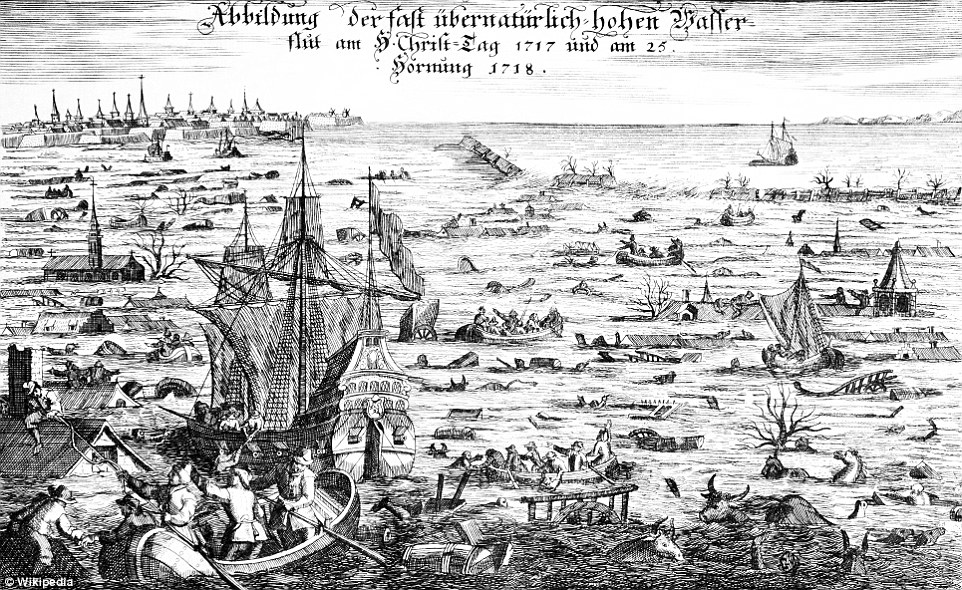
The apocalyptic weather caused enormous floods to submerge coastal areas in the Netherlands, Northern Germany and Denmark by Christmas Day. Pictured: A contemporary drawing that shows the devastation wrought in Northern Europe by the storm and flood
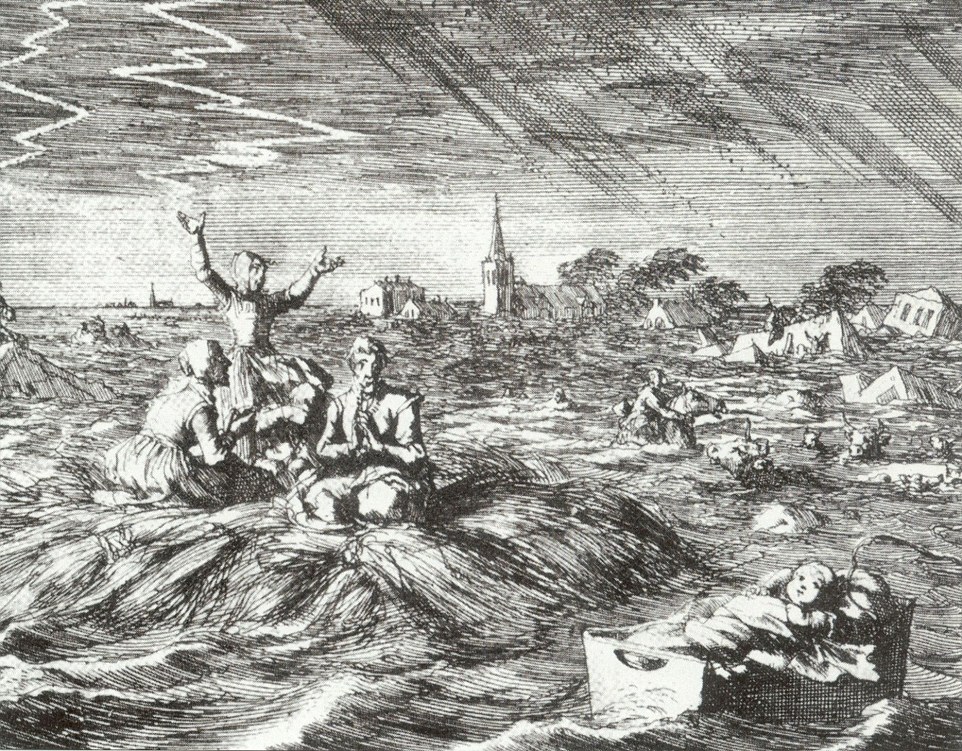
As the surviving population struggled with the wind and the waves, Arctic gales spread across the continent and caused a crippling frost to descend on the suffering victims. Pictured: A contemporary sketch showing the cataclysmic damage caused by the storm. In the bottom right of the image is a baby drifting on the water
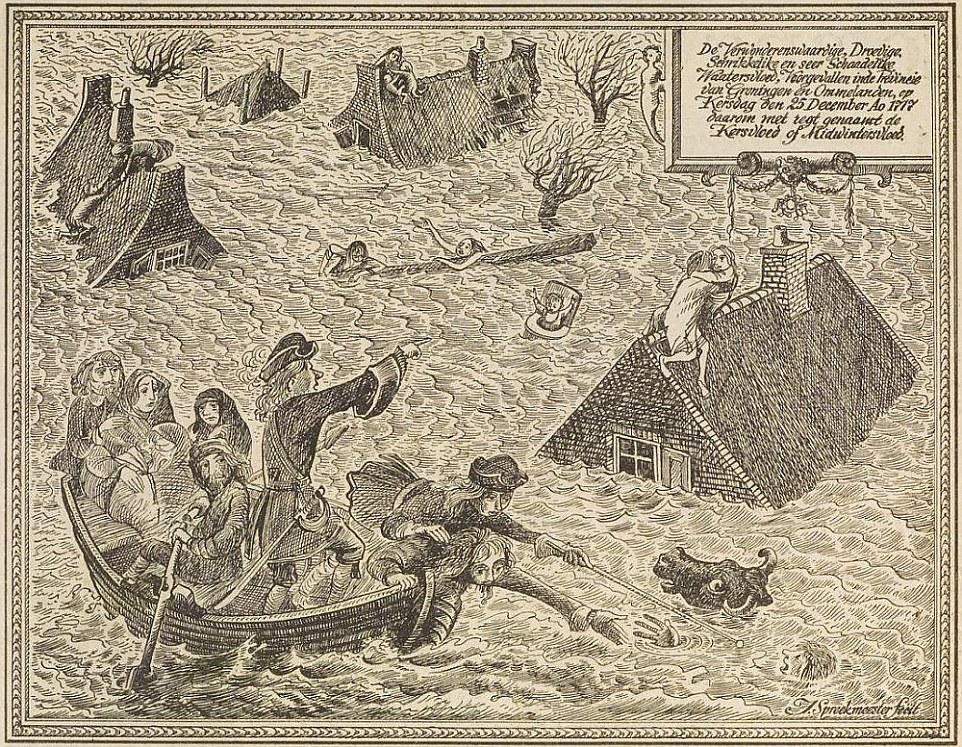
In the city of Groningen, the worst affected area of all, 2,300 people were killed - an astonishing number given the population at the time was just over 80,000. Pictured: An image showing the disaster in Groningen, with animals and people both suffering in the flood
Across the Continent, coastal dikes cracked and collapsed under the intense pressure of the hurricane-propelled waters.
Devastatingly, the force of the water was strengthened by the tides coming in at around the same time as the storm was raising sea levels.
In the city of Groningen, the worst affected area of all, 2,300 people were killed - an astonishing number given the population at the time was just over 80,000.

Professor Raingard Esser (pictured), director of the Groningen Research Institute for the Study of Culture at Groningen University and author of books on the topic, said the calamitous flood was 'one of the greatest nature-induced disasters in early modern history'
Professor Raingard Esser, director of the Groningen Research Institute for the Study of Culture at Groningen University and author of works on the topic, said the calamitous flood was 'one of the greatest nature-induced disasters in early modern history'.
Compounding the misery of the unfortunate victims in the Netherlands, administrators seeking to avoid a repetition in the future taxed locals so new flood defences could be constructed.
Meanwhile priests, feeling no less sympathetic, blamed parishioners and their sinful ways for the disaster, admonishing them to repent and by so doing save the country.
All this occurred in a post-flood environment of desperate food shortages and homelessness.
The storm, flood and freezing weather had killed thousands of farm animals, wrecked crops and smashed houses to pieces.
But it wasn't relentlessly disastrous - there were some positive outcomes.
Dike builders and water engineers were incensed by the cataclysm, blaming not a wrathful god but improvident town planners.
Professor Esser explains that obliterated Groningen was among the first cities to rework its tidal defences.
The city's chief water engineer, commis provinciaal Thomas van Seeratt, was at the forefront of the revolution.
'He proposed the construction of higher and better fortified dikes and was successful in realising his projects in the province (against some resistance of some local farmers, who refused to contribute to the additional costs),' Professor Esser said.
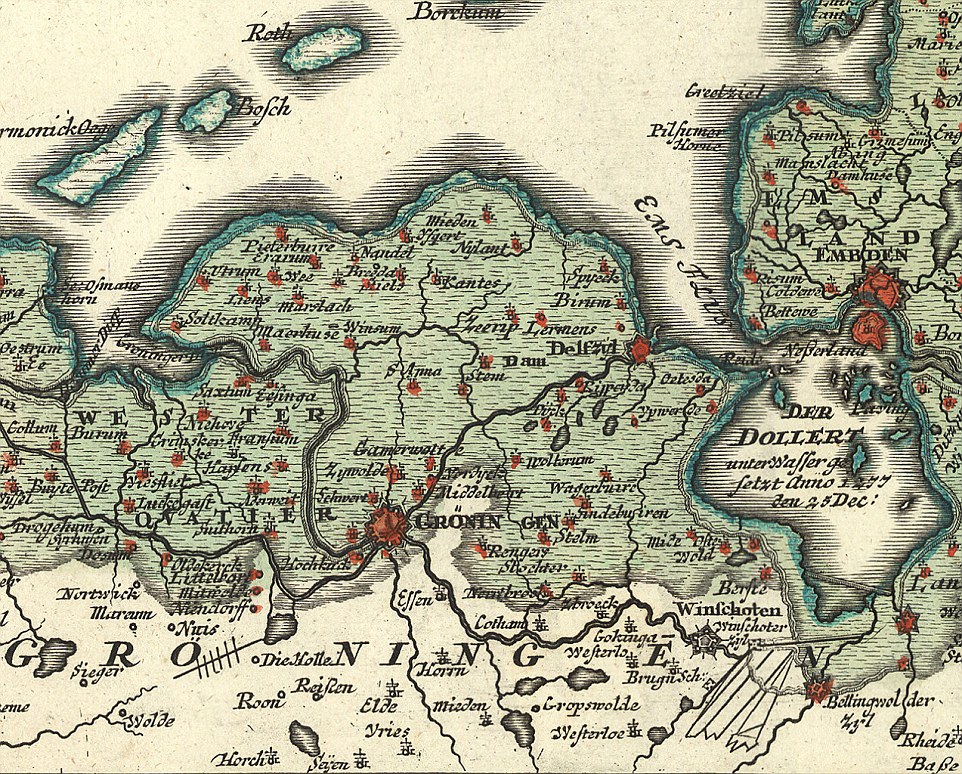
Compounding the misery of the unfortunate victims in the Netherlands, administrators seeking to avoid a repetition in the future taxed locals so new flood defences could be constructed. Above can be seen the affected areas around Groningen, which suffered unparalleled damage
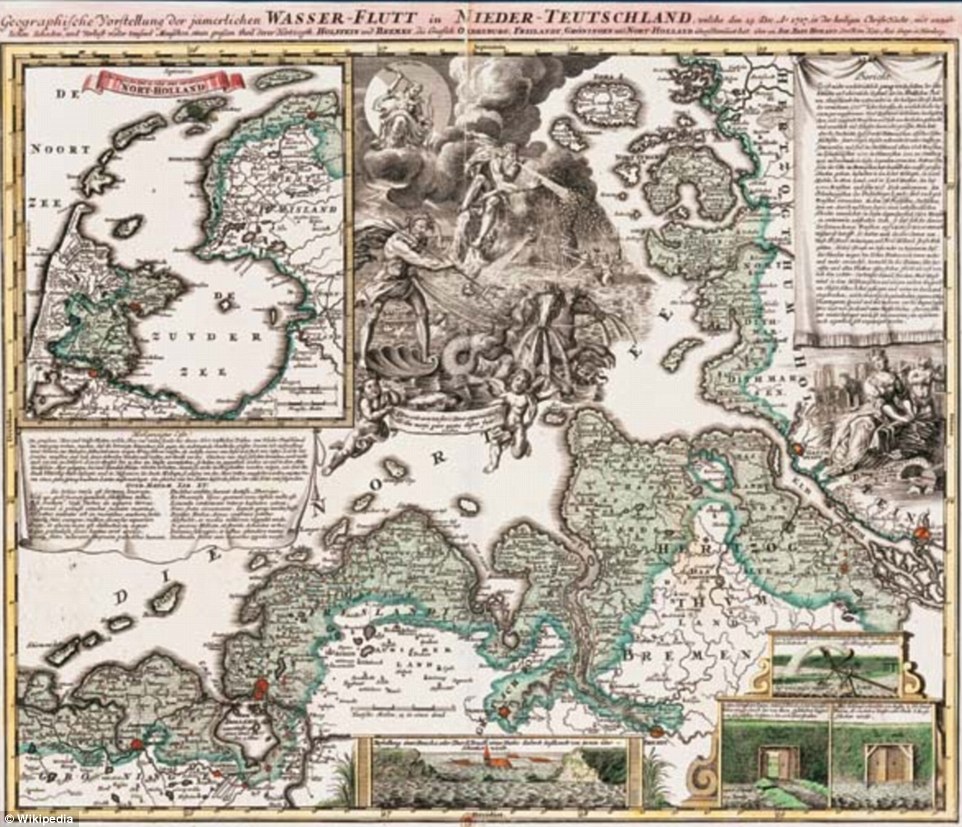
The storm and flood were only matched in strength over two centuries later, during the disaster of 1953. Shown above is a larger map highlighting the affected areas (in green), with Germany and Denmark shown in the east
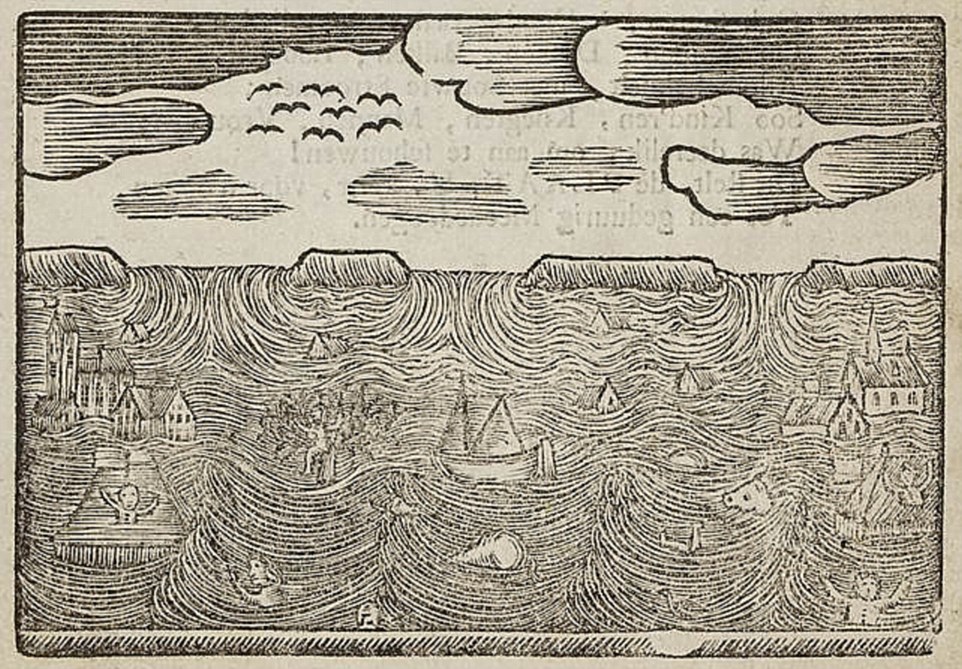
Professor Esser explains that obliterated Groningen was among the first cities to rework its tidal defences. The city's chief water engineer, commis provinciaal Thomas van Seeratt, was at the forefront of the revolution. Pictured: A simple drawing showing the annihilation of a settlement during the flood
'His construction of enlarged dike bodies prevented dike erosion and, ultimately, further disasters of the Christmas Flood scale.'
Van Seeratt, a Swede, recorded his technical calculations for dike construction in later texts, guaranteeing his advances in technology were not forgotten.
The storm and flood were only matched in strength more than two centuries later, during the disaster of 1953.
But by then much of Europe had learned from the lesson of 1717 and created functional defence systems.
As a consequence, there were 2,551 deaths in 1953 rather than the catastrophic losses of the 18th century.
But nonetheless, the crushing disaster of 1717 is now seen in the context of Dutch decline.
The country had experienced its golden age in the 17th century but, with this storm combining with other setbacks (including pressure from the growing British Empire), its time as a dominant European power was brought to an end.
Dr Raingard Esser, who has been teaching a special masters course named 'Coping with Crisis' in the build-up to the disaster's 300th anniversary, is the director of Groningen University's Classical, Medieval and Early Modern Studies research programme. She has also been deeply involved in the city's plans to mark three centuries since the Christmas Flood.
Read more: Remembering the Christmas Flood of 1717 | Daily Mail Online
Follow us: @MailOnline on Twitter | DailyMail on Facebook
The apocalyptic weather caused enormous floods to submerge coastal areas in the Netherlands, northern Germany and Denmark by Christmas Day.
The Christmas Flood of 1717: How one of the most devastating storms in European history killed 13,700 people in Denmark, Germany and the Netherlands
On a cold Christmas Eve night, a hurricane-strength storm smashed into coastal areas around the North Sea
The storm caused massive flooding across Netherlands, northern Germany and Denmark by Christmas Day
It was followed by savage Arctic gales that combined with the wind and waves to kill estimated 13,700 people
Alongside the loss of human life, there was utter devastation to farming and livestock that caused lack of food
By Iain Burns For Mailonline
26 December 2017
On a chilly Christmas Eve three centuries ago, one of the most devastating storms in the history of Europe smashed into the coastlines around the North Sea, killing over 13,000 people, annihilating thousands of houses and wrecking countless farms.
The apocalyptic weather caused enormous floods to submerge coastal areas in the Netherlands, northern Germany and Denmark by Christmas Day.
As the surviving population struggled with the wind and the waves, Arctic gales spread across the continent and caused a crippling frost to descend on the suffering victims.
Britain, luckily, was spared the worst of the carnage - but some settlements in the Netherlands were almost completely destroyed.

The apocalyptic weather caused enormous floods to submerge coastal areas in the Netherlands, Northern Germany and Denmark by Christmas Day. Pictured: A contemporary drawing that shows the devastation wrought in Northern Europe by the storm and flood

As the surviving population struggled with the wind and the waves, Arctic gales spread across the continent and caused a crippling frost to descend on the suffering victims. Pictured: A contemporary sketch showing the cataclysmic damage caused by the storm. In the bottom right of the image is a baby drifting on the water

In the city of Groningen, the worst affected area of all, 2,300 people were killed - an astonishing number given the population at the time was just over 80,000. Pictured: An image showing the disaster in Groningen, with animals and people both suffering in the flood
Across the Continent, coastal dikes cracked and collapsed under the intense pressure of the hurricane-propelled waters.
Devastatingly, the force of the water was strengthened by the tides coming in at around the same time as the storm was raising sea levels.
In the city of Groningen, the worst affected area of all, 2,300 people were killed - an astonishing number given the population at the time was just over 80,000.

Professor Raingard Esser (pictured), director of the Groningen Research Institute for the Study of Culture at Groningen University and author of books on the topic, said the calamitous flood was 'one of the greatest nature-induced disasters in early modern history'
Professor Raingard Esser, director of the Groningen Research Institute for the Study of Culture at Groningen University and author of works on the topic, said the calamitous flood was 'one of the greatest nature-induced disasters in early modern history'.
Compounding the misery of the unfortunate victims in the Netherlands, administrators seeking to avoid a repetition in the future taxed locals so new flood defences could be constructed.
Meanwhile priests, feeling no less sympathetic, blamed parishioners and their sinful ways for the disaster, admonishing them to repent and by so doing save the country.
All this occurred in a post-flood environment of desperate food shortages and homelessness.
The storm, flood and freezing weather had killed thousands of farm animals, wrecked crops and smashed houses to pieces.
But it wasn't relentlessly disastrous - there were some positive outcomes.
Dike builders and water engineers were incensed by the cataclysm, blaming not a wrathful god but improvident town planners.
Professor Esser explains that obliterated Groningen was among the first cities to rework its tidal defences.
The city's chief water engineer, commis provinciaal Thomas van Seeratt, was at the forefront of the revolution.
'He proposed the construction of higher and better fortified dikes and was successful in realising his projects in the province (against some resistance of some local farmers, who refused to contribute to the additional costs),' Professor Esser said.

Compounding the misery of the unfortunate victims in the Netherlands, administrators seeking to avoid a repetition in the future taxed locals so new flood defences could be constructed. Above can be seen the affected areas around Groningen, which suffered unparalleled damage

The storm and flood were only matched in strength over two centuries later, during the disaster of 1953. Shown above is a larger map highlighting the affected areas (in green), with Germany and Denmark shown in the east

Professor Esser explains that obliterated Groningen was among the first cities to rework its tidal defences. The city's chief water engineer, commis provinciaal Thomas van Seeratt, was at the forefront of the revolution. Pictured: A simple drawing showing the annihilation of a settlement during the flood
'His construction of enlarged dike bodies prevented dike erosion and, ultimately, further disasters of the Christmas Flood scale.'
Van Seeratt, a Swede, recorded his technical calculations for dike construction in later texts, guaranteeing his advances in technology were not forgotten.
The storm and flood were only matched in strength more than two centuries later, during the disaster of 1953.
But by then much of Europe had learned from the lesson of 1717 and created functional defence systems.
As a consequence, there were 2,551 deaths in 1953 rather than the catastrophic losses of the 18th century.
But nonetheless, the crushing disaster of 1717 is now seen in the context of Dutch decline.
The country had experienced its golden age in the 17th century but, with this storm combining with other setbacks (including pressure from the growing British Empire), its time as a dominant European power was brought to an end.
Dr Raingard Esser, who has been teaching a special masters course named 'Coping with Crisis' in the build-up to the disaster's 300th anniversary, is the director of Groningen University's Classical, Medieval and Early Modern Studies research programme. She has also been deeply involved in the city's plans to mark three centuries since the Christmas Flood.
Read more: Remembering the Christmas Flood of 1717 | Daily Mail Online
Follow us: @MailOnline on Twitter | DailyMail on Facebook